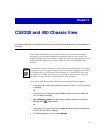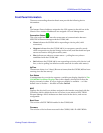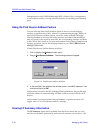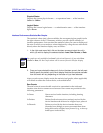
CSX200 and 400 Chassis View
2-8 Viewing Chassis Information
¥ Bridge Ñ FWD, DIS, LRN, LIS, BLK, BRK, or UNK
¥ Bridge Mapping Ñ bridge interface index numbers
¥ Admin Ñ ON or OFF
¥ Operator Ñ ON or OFF
If you have selected the Bridge status mode, a port is considered:
¥ FWD (Forwarding) if the port is on-line and forwarding packets across the
CSX200/400 from one network segment to another.
¥ DIS (Disabled) if bridging at the port has been disabled by management; no
trafÞc can be received or forwarded on this port, including conÞguration
information for the bridged topology.
¥ LRN (Learning) if the Forwarding database is being created, or the Spanning
Tree Algorithm is being executed because of a network topology change. The
port is monitoring network trafÞc, and learning network addresses.
¥ LIS (Listening) if the port is not adding information to the Þltering database. It
is monitoring Bridge Protocol Data Unit (BPDU) trafÞc while preparing to
move to the forwarding state.
¥ BLK (Blocking) if the port is on-line, but Þltering trafÞc from going across the
CSX200/400 from one network segment to another. Bridge topology
information will be forwarded by the port.
¥ BRK (Broken) if the physical interface has malfunctioned.
¥ UNK (Unknown) if the interfaceÕs status cannot be determined.
If you have selected Bridge Mapping, the port status boxes will display the bridge
interface index numbers assigned to each interface (which may or may not match
the ifIndex values displayed via the I/F Mapping option described below).
If you have selected the Ad
min status mode, a port is considered:
¥ ON if the port is enabled by management and has a valid link.
¥ OFF if it has not been enabled or if it has been disabled through management
action.
If you have selected the Operator status mode, a port is considered:
¥ ON if the port is currently forwarding packets.
¥ OFF if the port is not currently forwarding packets.
Load
If you choose Load, the interface text boxes will display the percentage of
network load processed by each port during the last polling interval. This
percentage reßects the network load generated per polling interval by devices


















